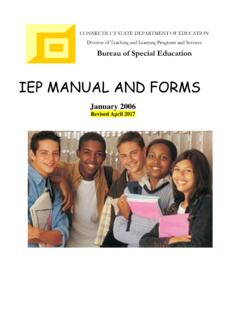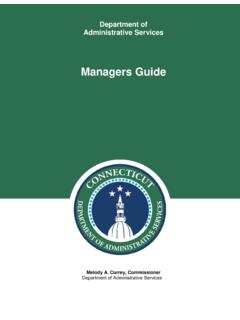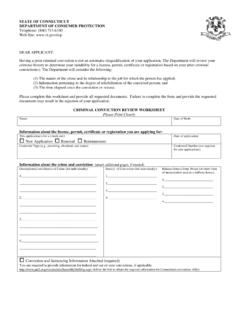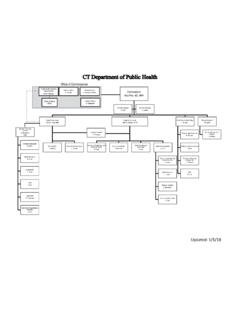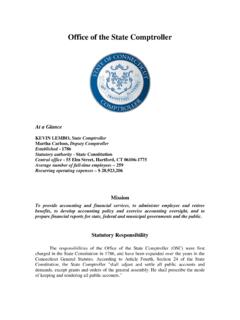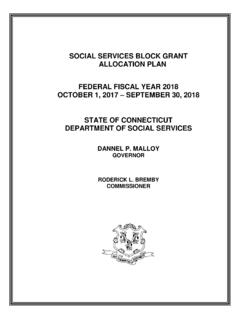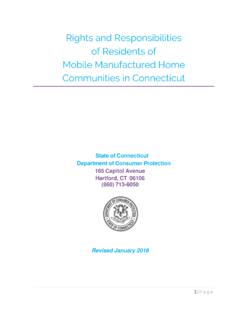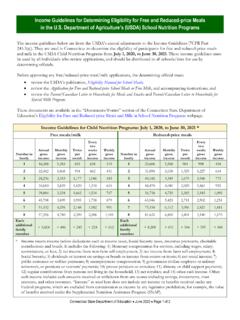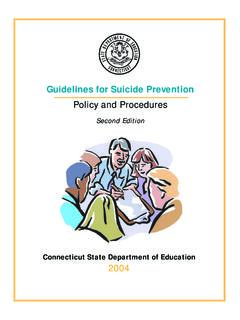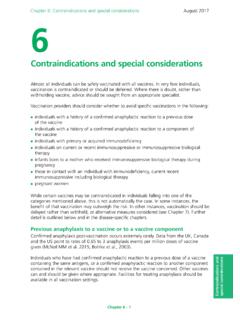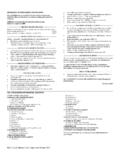Transcription of Updated Considerations for Quarantine, Isolation, Testing ...
1 1 Updated : January 10, 2022 Updated Considerations for Quarantine, Isolation, Testing , and Contact Tracing Policies and Procedures in PreK-12 Schools Frequently Asked Questions 1. Why is there no mention of COVID-19 vaccine booster doses in the DPH PreK-12 guidance as there is in the Centers for Disease Control and Prevention s (CDC s) Updated guidance for quarantine and isolation? In their most recent guidance for quarantine and isolation (dated January 9, 2022), CDC advised that for adults 18 years and older, only those who have received a booster dose of COVID-19 vaccine should be included in the group of individuals not required to quarantine at home after a close contact with a known COVID-19 case, whereas individuals younger than 18 years need only be fully vaccinated.
2 The rationale considered by the Connecticut State Department of Education (CSDE) and Department of Public Health (DPH) regarding the decision to continue to allow fully vaccinated students and staff to continue with in-person learning after a close contact, provided they remain asymptomatic, is that unlike many environments and activities that are applicable to the general public, the environments inside PreK-12 schools in Connecticut are likely lower risk than most other publicly-accessible environments in that there are generally a higher percentage of vaccinated individuals inside schools, and compliance with strict mitigation strategies inside our schools, including consistent and correct masking at all times, is strong and almost universally implemented.
3 However, regardless of whether it is required as a prerequisite for avoiding quarantine, now that all children ages 12 and older are eligible for booster COVID-19 vaccine doses, we urge school districts to encourage all students and staff to get a COVID-19 booster vaccine dose as soon as they are eligible to further reduce the risks of transmission and negative impacts on our schools and communities. 2. If schools are no longer doing contact tracing for in-school exposures, can they also stop keeping track of appropriate quarantine/isolation durations and dates of return to activities for students and staff who have been identified as having COVID-19 or been directed to quarantine as a close contact? No. Schools that have been notified by health officials or individuals/parents/guardians of a student or staff person who has tested positive, is in quarantine, or is not participating with in-person learning due to symptoms that may be associated with COVID-19 should continue to monitor those individuals, enforce restrictions from in-person learning and other school activities according to the appropriate time schedule, and communicate when and to what activities individuals can return.
4 However, if notified of a COVID-19 case who may have had contact with others in school during their infectious 2 Updated : January 10, 2022 period, schools no longer need to retroactively contact trace any possible close contacts that may have occurred during the school day. Schools that choose to discontinue contract tracing are strongly encouraged to put in place and utilize a system for notification of staff and families of positive cases, as indicated in the guidance document. 3. Do schools need to continue reporting cases among students and staff to the DPH School Submissions portal, even if we aren t contact tracing anymore? Yes. Schools should continue to report all cases (no matter which type of test returns the positive result) among students and staff they are aware of to the DPH School Submissions portal.
5 DPH Submissions - Login Page ( ) 4. Does the PreK-12 guidance for duration of quarantine and isolation apply to extracurricular activities like athletics? Updated interscholastic, club, and recreational youth sports guidance will be released soon. The general principles of this Updated guidance can be applied to other extracurricular activities as well. 5. The guidance indicates that individuals can return from quarantine/isolation after 5 days but should continue to wear a mask around others for an additional 5 days. If a student cannot consistently and correctly wear a mask either for developmental reasons or due to a mask exemption, should they be allowed to return after 5 days or should they remain quarantined/isolated for 10 days?
6 The inability to consistently and correctly wear a mask due to developmental issues or medical contraindications alone should not be a basis for not allowing return to school activities. CSDE has indicated that schools must assess, on an individualized basis, the appropriate accommodations for students with disabilities who are unable to wear a mask. In addition, students and staff involved with certain special education activities like speech therapy or where lip reading is required may need to be exempted from wearing a face covering mask intermittently. In cases where an exception is requested based upon a disability, a planning and placement team (PPT) or Section 504 meeting as appropriate should be held to consider possible programming revisions or appropriate accommodations.
7 In those cases where face covering masks will not be in use, the effective use of other key mitigation strategies such as maximizing distancing, moving activities outdoors or to a well-ventilated space, and/or the use of face shields or other physical barriers will be extremely important to the protection of the students and staff involved. 6. Should schools isolate returning students during meal periods when masks will be removed during days 6-10? Schools do not need to implement any individual restrictions around school day activities once individuals return to in-person learning, as managing various return dates, schedules, activities, etc. would not be operationally viable in most districts and would likely lead to more restrictive guidance than is necessary in most cases.
8 The general advisory from DPH has always been to ensure that during meal periods students are always kept as spaced as possible and that masking be strictly enforced during meal periods when individuals are not actively eating or drinking. If not already doing so, 3 Updated : January 10, 2022 schools should increase their efforts to reinforce those mitigation strategies in places like cafeterias by ensuring that masks are only pulled down or removed for the amount of time it takes someone to actively eat or drink and then immediately be replaced and worn correctly. Also, ensuring that spacing is maintained throughout the meal period and students do not move closer together for the purposes of social interaction during lunch can help to reduce risk.
9 If mitigation strategies can be followed consistently and enforced, the brief amount of time any student might be unmasked during a meal period is unlikely to significantly impact the risk from any student who would return after a 5-day isolation period. 7. In the past, negative self-test ( , home test ) results have not been accepted as valid for early release from quarantine. Are those tests now acceptable in all situations? Are two tests required as indicated in the instructions for some self-tests or is one test acceptable? Yes. The Updated PreK-12 guidance allows for individuals who have COVID-19 symptoms to return to in-person learning once they are fever-free for 24 hours and any other symptoms are improving if they have a negative test result, which can be either PCR or antigen Testing .
10 At-home self- Testing is allowable in these situations because the predictive value of these tests is significantly higher when used to test symptomatic individuals than those without any COVID-19 symptoms. At this time, DPH advises that schools can rely on a symptomatic individual s positive or negative at-home test result as indicative of their current COVID-19 status. Some antigen self-test kits indicate that two tests over 2-3 days are required to verify that a negative test is not a false negative. These instructions generally apply to individuals who are Testing without having any symptoms. A particular concern could be in the case of a person who is not fully vaccinated and has no symptoms but is identified as a close contact of a known COVID-19 case.
